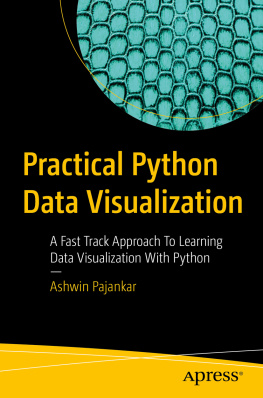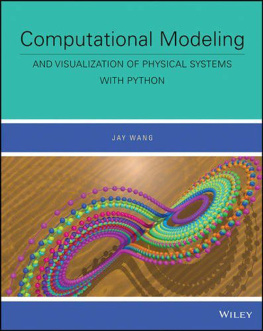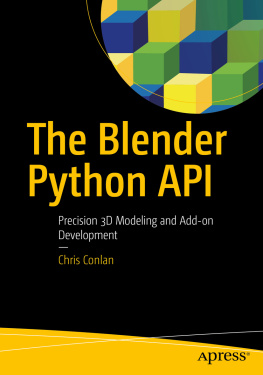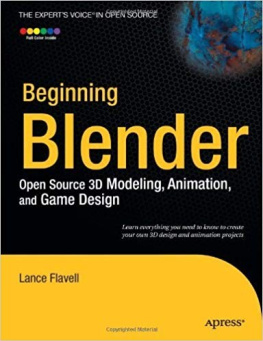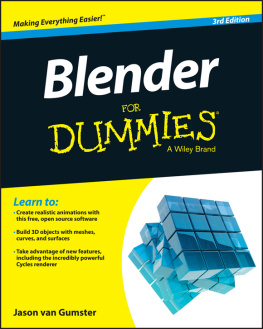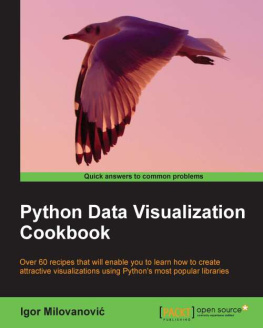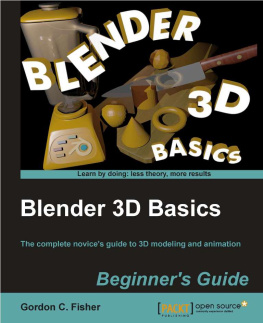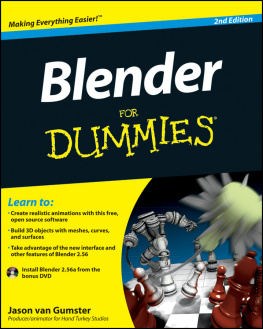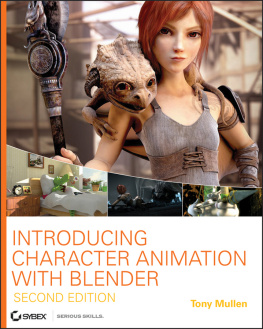3D Scientific Visualization
with Blender
Brian R Kent, PhD
National Radio Astronomy Observatory, Charlottesville, VA, USA
Morgan & Claypool Publishers
Copyright 2015 Morgan & Claypool Publishers
All rights reserved. No part of this publication may be reproduced, stored in a retrieval system or transmitted in any form or by any means, electronic, mechanical, photocopying, recording or otherwise, without the prior permission of the publisher, or as expressly permitted by law or under terms agreed with the appropriate rights organization. Multiple copying is permitted in accordance with the terms of licences issued by the Copyright Licensing Agency, the Copyright Clearance Centre and other reproduction rights organisations.
Rights & Permissions
To obtain permission to re-use copyrighted material from Morgan & Claypool Publishers, please contact .
ISBN 978-1-6270-5612-0 (ebook)
ISBN 978-1-6270-5611-3 (print)
ISBN 978-1-6270-5614-4 (mobi)
DOI 10.1088/978-1-6270-5612-0
Version: 20150301
IOP Concise Physics
ISSN 2053-2571 (online)
ISSN 2054-7307 (print)
A Morgan & Claypool publication as part of IOP Concise Physics
Published by Morgan & Claypool Publishers, 40 Oak Drive, San Rafael, CA, 94903, USA
IOP Publishing, Temple Circus, Temple Way, Bristol BS1 6HG, UK
This book is dedicated to Linda Kent.
Contents
Preface
Observations, experiments and simulations in the sciences often have high impact visuals that never cease to provide insight into the Universe. This book is the result of exploring comprehensive software packages in 3D visualization for research in astronomy and astrophysics. Surveying the broader scope of a variety of scientific fields, we can see that the incredible results of our experiments can benefit in communicating results to both the scientific community as well as a broader audience.
This book is intended for the individual investigator or ambitious student to begin learning the fundamentals of 3D visualization for science. We utilize Blender, an agile and comprehensive software package for data visualization and animation. The application programming interface allows scientists to import and manipulate their data through the Python language. After introducing the fundamentals, the book concludes with a number of illustrative projects to bring various components together culminating in a series of visualizations.
A website is also available as a companion to the book with example files and videos providing the user with step-by-step instructions on principles and projects outlined in the text. It is my hope that these will serve as a launching point for scientists to take their data visualizations to the next level.
Acknowledgments
Blender is a registered trademark of the Blender Foundation. The author would like to thank Matthew Wood for directing me to the IOP Concise Physics series with Jeanine Burke and Joel Claypool of Morgan & Claypool Publishers, David Thomas for the Lagrange point calculations and Linda Kent for her encouragement. Members of the astronomical community and ACM SIGGRAPH conference provided useful queries that helped in developing the ideas of this book. The National Radio Astronomy Observatory is a facility of the National Science Foundation operated under cooperative agreement by Associated Universities, Inc.
Author biography
Brian R Kent

Brian R Kent, PhD is a scientist with the National Radio Astronomy Observatory in Charlottesville, Virginia. His publications and studies in astrophysics and computing include scientific visualizations of a variety of theoretical and observational phenomena. He is interested in visualizing data for scientific analysis as well as reaching a broad audience with the stunning visuals that modern 3D graphics can provide. Dr Kent received his PhD in Astronomy and Space Sciences from Cornell University. His website is: http://www.cv.nrao.edu/~bkent/
IOP Concise Physics
3D Scientific Visualization with Blender
Brian R Kent
Chapter 1
Introduction
1.1 Visualization in the sciences
Science is all-encompassing with its ability to provide a logical path to facts, revolutionize technology and change the world as we know it, as well as inspire the next generation of technological advancements. Through the scientific method we form questions and develop hypotheses, and visualization of data plays a key role in testing and analysis. Insight into experiments is often found by how we present scientific and engineering results, concepts and ideas to all audiences, both non-scientific and scientific.
Modern computing has given the scientific community tools to take data exploration to the next level. The mining of large data sets requires efficient data organization as well as visualization. At times this is due to the sheer disk size of data, limited by memory or processing power. Developments in graphics processing units (GPUs), both for driving high-end graphics applications and threaded processing, allow for sophisticated high resolution images and animations to be created. In other scenarios the data may have a complex phase space to explore. Data may have N-dimensional tables or correlations among quantities that only reveal themselves through 3D visuals.
Many cutting-edge studies in a variety of scientific disciplines benefit from scientific visualization.
Astronomy. Telescope observations across the electromagnetic spectrum now generate terabytes of data every hour. Storing and managing the raw data is a challenge, let alone visualizing the processed data that have been pushed through the necessary calibration procedures. A survey of a million galaxies from a single wavelength regime will have metadata that need to be appropriately organized and indexed to search efficiently [].
Physics. Cutting edge projects such as the Large Hadron Collider require advanced visualization software []. Visualizing scientific apparatus before they are designed can help to optimize the engineering and design of experiments.
Chemistry/Biology. Complex molecules and molecular dynamics during reactions can be examined with 3D animations [].
Geography/Planetary Science. A wealth of mapping data exist, not only for the planet Earth, but other surveyed planets in our Solar System. Using special data storage models and GPU processing, 3D maps of planetary surfaces can now be rendered in real time [].
Medicine. Visualizing computed axial tomography (CAT scans) can show a transparent view of organic structures. Classification and feature extraction while performing diagnoses benefits greatly from be able to view real time 3D movies of internal organs [].
1.2 What is Blender?
Blender is open source software that allows a user to create high quality animations of 3D models and data. It has wide usage in the video game and entertainment industries. The software is also extremely useful for generating high quality scientific visualizations. With its well organized Python application programming interface (API), it can be scripted to load data from numerical simulations. The power of Blender becomes evident when the user is given complete control over the camera angle, field of view and rendering aspects of the final animation.
Blenders traditional user base has been 3D graphics specialists working in modeling and animation. However, with the intuitive graphical user interface (GUI) and availability of Python libraries for reading a variety of scientific data, Blender brings an exciting and unique visualization suite to the modern scientific workbench. Developer/creator Ton Roosendaal and the Blender Foundation have created a community to maximize the amount of on-line material for developers and users. The goal of this book is to provide the reader with an interesting and practical introduction to Blender by way of science examples, each showing important software features and 3D graphics techniques.
Next page

